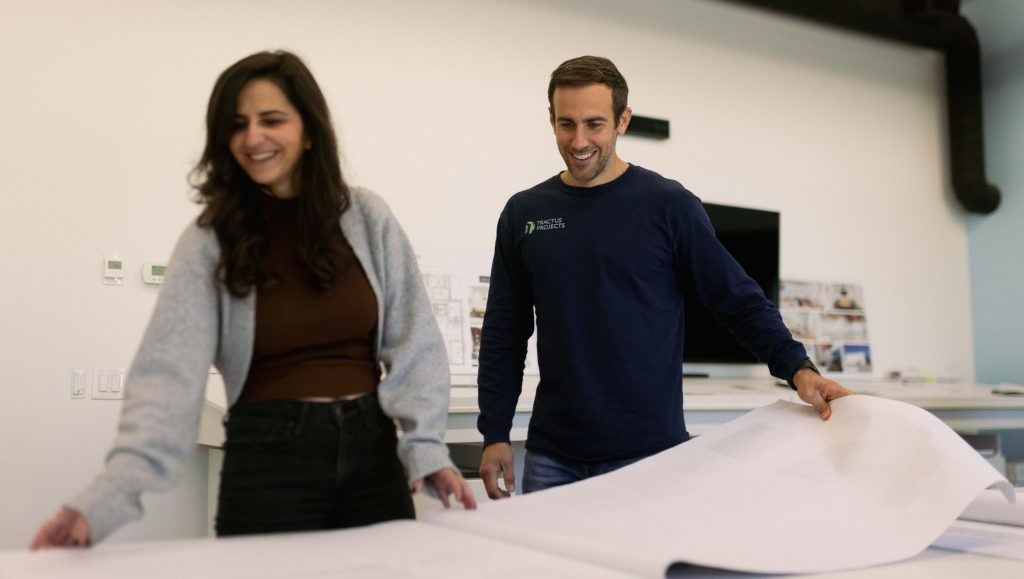by Kelly Smith

From corner offices to kitchen tables, where work happens has become one of the defining questions for our industry. BOMA members are weighing in with perspectives that reflect both tradition and change. To capture those perspectives, BOMA Manitoba surveyed the full membership, with 58 participants responding. Input came from both allied and principal firms, representing a range across various roles and sectors.
The results reveal how workplace strategies shape career development, tenant experience, and the city centre.
What emerges from the feedback is a spectrum. Some organizations remain fully in-office, others allow limited remote work, and many are adopting hybrid approaches. Their choices differ, but the impact is similar. These decisions ripple outward, shaping careers, retention, and the vibrancy of downtown Winnipeg.
“Primaris has adopted a mix of workplace models throughout the organization to meet employees’ needs and ensure individual success. The focus is on communication and productivity while providing flexibility to support and promote a strong work-life balance.”
-Pearce McDonald, Property Manager, Primaris REIT
Why Companies Choose Their Models
When asked what drove their current approach, those surveyed overwhelmingly pointed to teamwork (64%), company culture (59%), and productivity (53%) as the top factors. Executive preference and employee feedback also played a role, though less consistently.
Just as BOMA has long noted that connections at our events deepen through repeated, face-to-face interactions, the same principle applies inside the workplace. Informal learning and spontaneous conversations were consistently described as benefits that are hard to recreate remotely.
A third of the companies surveyed said workplace models were decided primarily at the leadership level, reflecting strategic priorities on company values, productivity, and collaboration. The survey suggests that how employees experience these decisions day-to-day is just as important to making any approach work.
As one respondent explained, “Productivity and collaboration have improved substantially since returning to work. There is also the ability to work closely with staff that require more guidance.”
“A fully in-office environment fosters spontaneous collaboration, real-time problem solving, and deeper mentorship opportunities that are difficult to replicate remotely. Being physically present enables stronger team cohesion, quicker feedback, and a shared culture that accelerates learning.”
– Jim Moore, General Manager, True North Real Estate
The In-Office Advantage
For many responding companies, the strongest case for office-based models comes down to culture, mentorship, and career growth. Several respondents pointed out that young professionals in particular benefit from being able to watch and learn from experienced colleagues in real time. Informal conversations, quick problem-solving, and spontaneous teamwork were all cited as advantages that can be difficult to duplicate from the comfort of home.
Several surveyed companies also tied in-office presence to employee retention, noting that teams with a stronger sense of culture and connection are often more engaged long term. For younger professionals especially, the opportunity to build relationships and receive mentorship in person was described as an important factor in career growth.
The impact extends beyond employees to the buildings themselves. Active offices sustain steady tenant demand, support leasing fundamentals, and make lobbies, common areas, and amenities feel vibrant.
Small details such as a busy café counter or a lobby full of movement contribute to a property’s overall energy and appeal, reinforcing the value of keeping workplace spaces active.

Tractus Projects
Remote as a Minority Voice
Only one respondent identified their organization as fully remote, underscoring how rare this model remains within BOMA Manitoba’s network. For a sector built on the value of office assets, remote work has always been the outlier. Still, even as a minority perspective, it continues to influence the conversation.
Survey feedback showed that the strongest arguments for remote work are financial and personal. Eliminating parking, fuel, and commuting costs was seen as a significant benefit. Responding firms also note that time regained from travel could be redirected toward family responsibilities, health, or personal well-being. Parents and caregivers in particular described how flexibility helped balance the demands of work and home.
Even so, the challenges were clear. Remote arrangements were described as making culture harder to sustain, informal learning more difficult, and making coordination less effective. A few respondents felt there were “no challenges,” showing how perspectives can diverge, but most acknowledge that physical distance requires trade-offs.
For BOMA members, remote work is less about an industry-wide shift and more about understanding the pressures that lead employees to value it. Cost, time, and balance will remain part of the conversation, even if full remote adoption continues to be rare in commercial real estate.
“Our Hybrid Workplan blends the value of collaboration and mentorship by establishing consistent in-office days for the team, while empowering professionals to manage their remote working days in a way that makes sense for their projects, careers, and families. This maximizes training, team building, and efficiency and is good for our people.”
– Timothy Reeve, Building Science Engineer, WSP Canada
Hybrid as the Middle Ground
Hybrid emerged as the top preference among those surveyed, with roughly 40- 45% identifying it as the model that best balances business needs with employee expectations. Contributors described hybrid as a way to preserve the organizational culture and mentorship of on-site work, while also providing the flexibility that supports morale and retention.
Flexibility in scheduling was a recurring theme. Even one to two remote days a week made a difference for well-being, and adjusted hours gave staff more control without reducing collaboration.
As Jaret Horbatiuk, owner of Tractus Projects, explained, “Hybrid has been part of how we work for years, and we see it continuing to evolve as our team grows. Being intentional about office time while allowing flexibility has been key to making it work.”
Members also observed that hybrid models succeed when in-office time is intentional, focused on teamwork, and client engagement, while individual work is often more productive at home. Ensuring that both groups feel connected was noted as essential, with several respondents pointing to the need for better meeting technology and practices to avoid leaving remote staff disconnected.
Hybrid models are also reshaping what companies look for in their space. Fewer dedicated desks may be required, but there is growing investment in flexible layouts, breakout areas, and amenities that make office time worthwhile. Leasing priorities and design decisions are shifting towards spaces that support both teamwork and individuals.

WSP Canada
Adaptations & Amenities
Survey participants highlighted a wide range of supports designed to make in-office work more appealing. Subsidized parking was the most common, followed by flex hours and wellness initiatives. Some organizations also mentioned social events and updated kitchens as tools to strengthen culture and encourage people to spend more time together at work.
Beyond these policies, many members are rethinking the workplace itself. They described investments in lounge-style gathering areas, café-inspired kitchens, fitness and wellness rooms, and hoteling workstations that can be reserved as needed. These amenities reflect a shift away from viewing the office as a place for routine deskwork and toward creating spaces that encourage connection, teamwork, and employee well-being.
Survey results showed that daily supports must reach beyond the office itself. Respondents highlighted childcare, healthcare, grocery, and safety as critical to making in-office work sustainable. These services are still limited downtown, but planned investments and redevelopment signal progress toward closing the gap.
Together, these adaptations show how members are working to align office life with today’s expectations. From on-site amenities to citywide services, the emphasis is on making the office not just a place to work, but a place that supports the whole employee experience.
The Ripple Effects on Downtown
While decisions about workplace models are made within individual companies, their impact is felt across the city. Survey respondents noted that when offices are occupied, restaurants fill at lunch, transit ridership rises, and retail activity grows. Parking lots, lobbies, and common areas feel busier, creating the energy that signals a thriving downtown.
The reverse is also true. Quiet floors and empty streets reduce momentum, which in turn influences tenant demand and leasing fundamentals. Members pointed out that building investments such as lobby renovations and new amenity spaces are harder to justify without consistent occupancy. For commercial real estate professionals, the presence of people quite literally keeps the ecosystem of commercial buildings running and sustains both asset value and the broader urban network.
Services are a key part of this equation. Employees are more willing to return when daily needs are met nearby. Survey respondents emphasized the importance of integrating essentials into the downtown core, and projects like the Portage Place redevelopment, which will bring housing, healthcare, and community services, show how these gaps are beginning to be addressed in the city centre.
As Jim Ludlow, President of True North Real Estate Development, explained, “Bringing essential services into the city core is about more than buildings. It is about creating a community where people want to live, work, and spend time.” The same applies to workplace strategies today, which are most effective when supported by a city environment that makes in-office life practical and sustainable.
Happy Employees, Happy Organization
The survey results confirmed what many members already suspected. There is no single right answer to the workplace model debate. Some organizations remain committed to fully in-office routines, others allow remote work in limited flex days, and many have settled into hybrid arrangements. Each approach reflects a balance of business priorities, culture, and employee needs.
What stood out most was that success does not come from choosing one model over another but from how these choices are carried out. Members emphasized that flexibility, communication, and intentionality are key. Leadership vision is important, but so is listening to employees and adapting policies to reflect their needs.
For commercial real estate professionals, these decisions ripple far beyond the office walls. They shape tenant demand, leasing strength, and the overall vitality of downtown Winnipeg. When workplace strategies evolve alongside employee expectations, they support retention and morale while sustaining the ecosystem of services, amenities, and communities that give the city its energy.
In the end, one size does not fit all. The most effective models are those that combine business goals with empathy for the people who make organizations work. As one member put it simply, “Happy employees, happy organization.”
